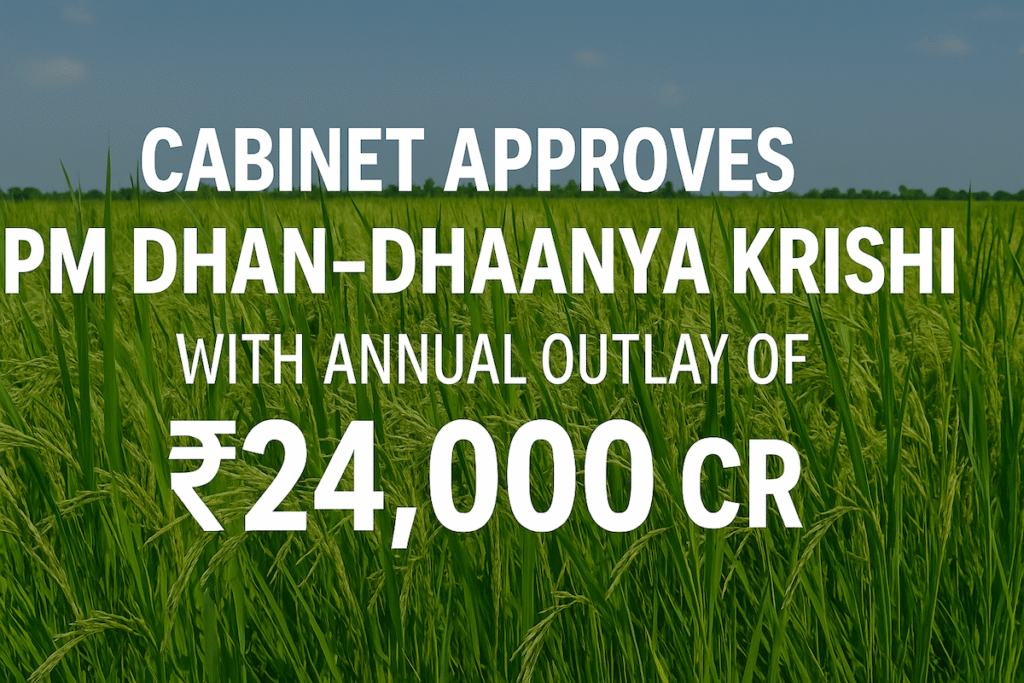The government has greenlit a major farming scheme called the PM Dhan-Dhaanya Krishi Yojana. It’s a six-year plan with an annual budget of Rs 24,000 crore. This is not just another rural project—it’s aimed directly at helping farmers who have been stuck in low-yield zones for years.
The scheme was first announced during the 2025 Union Budget. Now it’s official. Over 1.7 crore farmers across 100 districts will be part of it. These are areas where crops don’t grow well, irrigation is weak, and farmers get little credit support.
The goal is simple. Boost productivity. Get farmers better tools. Build support systems that actually work.
What Will the Scheme Do?
A lot, if things go as planned.
This scheme is going to bring change at the root level. Farmers will be trained to grow better crops and diversify what they plant. Not just wheat and rice—there’s going to be a push for pulses, oilseeds, and fruits too.
There’s a big focus on water. Many of these districts depend only on rain. So, new irrigation systems will be added. This could help farmers grow two or even three crops a year instead of just one.
Storage is another piece. Too much food gets wasted after harvest because there’s no place to keep it fresh. That’s going to change. Villages will get warehouses and cold storage centers. Processing units will come up too. That means more income for farmers and fewer middlemen.
Credit is a major issue in rural India. This plan will link farmers to banks and financial help. It’s expected to bring in more crop loans, insurance, and small business funding.
Where Will the Money Go?
Rs 24,000 crore each year is no small amount. But it won’t all be new spending. The scheme will pull together 36 existing programs from 11 ministries. Think of it as streamlining. Instead of running dozens of schemes with different names and rules, everything will now work under one umbrella.
State governments are involved too. They’ll help pick the districts and make sure the plans fit local needs. NABARD, the agriculture bank, will handle much of the funding and coordination.
How Will It Roll Out?
The model takes cues from the Aspirational Districts Program. That one worked by focusing on backward areas and pushing regular reviews. This will be similar—but all about farming.
Every state will have at least one selected district. So this won’t be just about big states or the Hindi belt. It’s meant to be nationwide.
What Are the Roadblocks?
Big plans often get stuck in the details. This one is no different.
To work well, the scheme needs clear communication, strong local officers, and tight checks. Merging multiple programs won’t be easy. And if money gets stuck or misused, farmers may not see the benefits for years.
Also, many small farmers still don’t trust government systems. That has to change. The real test will be whether the help reaches the ground.
Why This Matters
Farmers in low-yield areas often feel forgotten. They face bad weather, poor tools, and no backup. This scheme is designed for them. If it works, it could turn things around.
More crops. Less waste. Higher income. That’s the hope.
Now it’s up to the system to deliver.
For tips, news leads, or guest post opportunities, write to [email protected]

Recent Posts
Angel One Stock Broker Review
Income Tax Alert: ITR Filing Last Date for FY 2024-25 (AY 2025-26)
TikTok in India: The Buzz, the Ban, and What’s Really Happening
Wordle Answer Today (August 20, 2025): Hints and Full Solution Explained
Google Expands Store in India and Faces Global Play Store Challenges
Ola Electric Shares Recover Strongly After Heavy Fall in 2025
Gold Price Today: Rates Fall as Strong Dollar Impacts Market
Shreeji Shipping Global IPO Sees Strong Demand, GMP Suggests Listing Gains
India Approves ₹62,000 Crore Deal for LCA Tejas Mark 1A, HAL Shares Gain
Mangal Electrical and Gem Aromatics IPOs Draw Investor Attention with Steady GMP
Regaal Resources Makes Strong Market Debut with 39% Premium on Listing Day
Buchi Babu Tournament 2025 Begins with Exciting Performances